- HOME >
- New Arrival at HOJO Online Shop
Tea made only from White Tea Trees
I have always been dreaming of making tea from a specific type of tea tree. I wish to collect the tea leaves from the tea tree that I personally selected and process it. This is half my hobby and half experimental based project. Throughout the years of my tea expedition in Yunnan, I met a tea manufacturer who could support my idea. I personally collect the fresh tea leaves and ask a reliable manufacturer to process it. Tea tree that I was interested was “White Tea Bush”. Out of natural farming tea garden, some tea trees becomes very white if they are grown under strong sun light and non-fertilized soil.

Very shabby white tea tree
If tea tree is without applying fertilizer, due to nitrogen deficiency it grows very slowly. As a result of slower growing speed, the plant also tries to reduce the overall photosynthesis. Under the circumstances, there is a very interesting phenomenon. Some of tree branches naturally dry out, and the number of tealeaf is reduced. Those tea trees show a very noticeable characteristic. The tree bark turns very white, like white birch tree. Interestingly, once the fertilizer is re-applied, the white tree becomes brown color again. Comparatively, those “white tea trees” have very less branches and leaves. Generally people may think it is very unhealthy tree or the tree that is dying. However, the tealeaf from this white tree is very sweet. It is not only sweet, but also giving a very clear and refreshing aftertaste. The tealeaf from the white-tea tree does not give bitter or astringent taste that normal tea does. Perhaps the tealeaf grown under harsh environment becomes very rich in content.
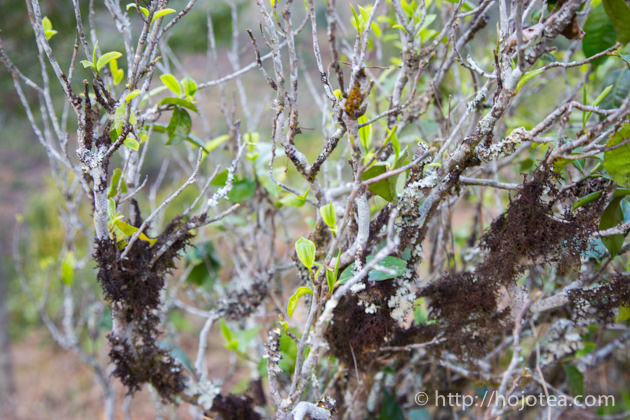


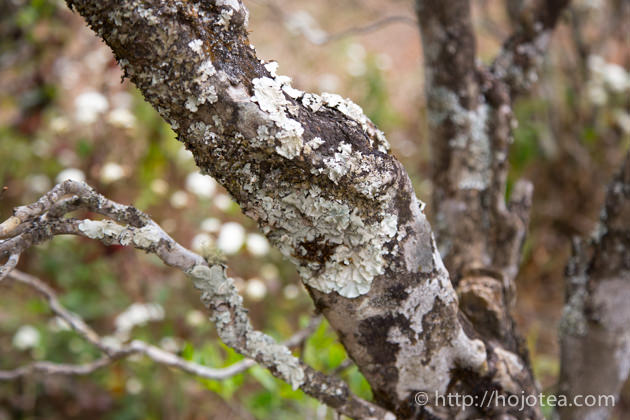
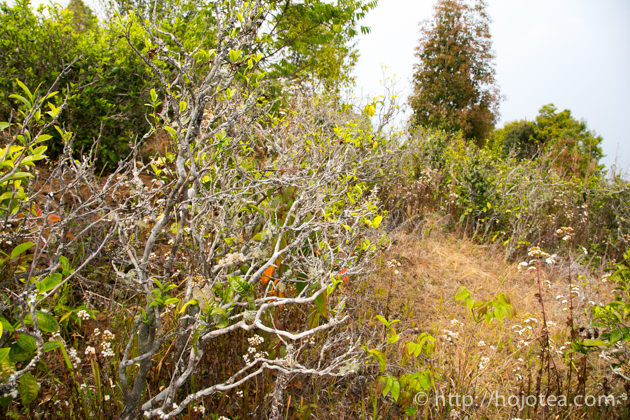



Our standard pu-erh tea is collected from the entire natural farming garden
I have been always interested in collecting only the specific type of tea leaves. My standard pu-erh teas are collected from natural farming garden too. However, usually the tea garden covers wide area and tea trees scatter everywhere. Somehow there are a variety of tea tree. Some of trees are grown under shade, some are directly expose to sunshine, some are very old trees and due to unknown factors some of them grow faster. The taste of tea grown under direct sun light and under shade is somehow different. When tea leaves are gathered from entire gardens and processed together, the taste of tea is homogenized. In fact, it is very important. For my standard pu-erh tea, I would like to achieve both clear and creamy taste.
The following photos show the common tea tree that bark is brownish



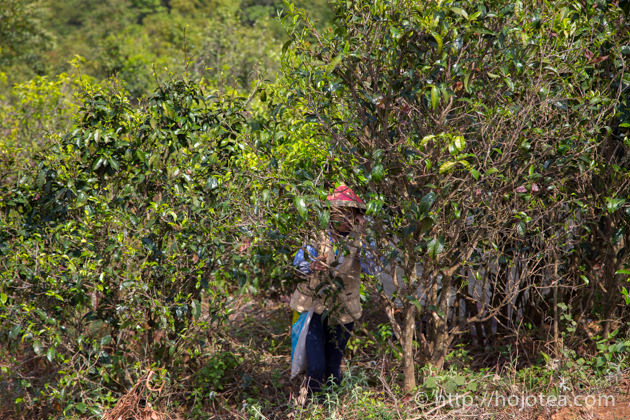
We look for the professional fresh tealeaf collector
This year, I wanted to produce tea collected only from the white tea tree grown under direct sun light. I am interested in making tea with a distinct characteristic. For achieving my desire, I had to selectively collect tea leaves from specific tea tree with very white tree bark. There are two ways for us to collect the fresh tea leaves. If we directly deal with farmer who owns the gardens, it is much cheaper. However, this method does not produce good outcome. In general, farmers pluck the fresh tealeaf and sell it to the tea manufacturer. Their earning comes from the total weight of tealeaf they collected in a day. In other words the more tealeaves the more earning, hence the plucking is very random. Eventually farmers tend to pluck tealeaf that does not meet our requirements. As we wish to collect the specific kind of tea leaf, we appoint professional fresh tealeaf collector. They live in the village, truly understood the tea trees condition and they are very good in management. They will follow the requirement of their client and educate the farmer to pluck according to the specification. I have asked help from my pu-erh tea manufacturer to introduce a reliable fresh tealeaf collector. She was indeed very competent and worked very hard to collect the tea from the white tea trees.
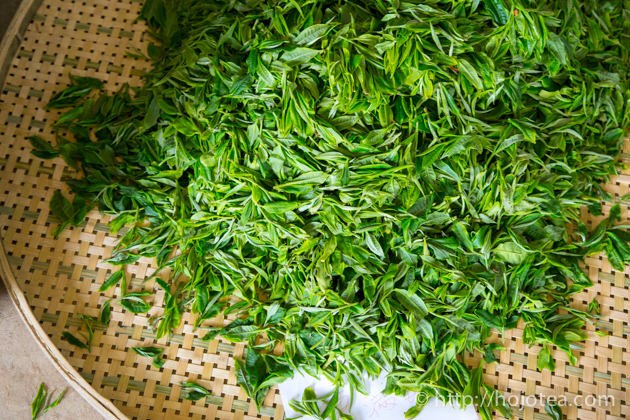
We selected tea gardens in Da Shan, a village located in Young De county of Lincang.

This is tea garden although it looks nothing but bushes.
Fascinating level of muscatel flavor
After spending some time surveying around, I have selected an ideal natural tea garden. The tea garden is left unattended for some time, surrounded by weeds and wild natural plants. The natural ecology is well-maintained and not disturbed by modern agriculture activities. After understanding the characteristic of tea from white tea tree, we decided to process into both raw pu-erh tea and black tea. Usually that extremely ecological tea gives a very intense muscatel flavor when it is either fermented or matured. I could foresee the black tea produced from this white tree will gives an excellent level of sweet muscatel flavor and clear drinking feeling. The black tea we processed from those white tea trees will be introduced as the successor of Yunnan Muscatel Black Tea.

Tea leaves after withering

Tea leaves after the rolling process

We only managed to produce about 30kg
When we kicked off this project, the collection of tea leaves was not progress very smoothly. Due to very stringent specification requested by us, it eventually takes much longer time to gather the tea leaves. Usually, if one wants to produce 10kg of tea, we need to gather about 40-50kg of fresh tealeaf. Initially I wanted to produce 50kg of raw pu-erh tea. So we needed at least 200kg of fresh tealeaf. However, after running the project for one week, we only managed to produce about to 30kg of raw pu-erh tea. When time passed-by, tealeaf grows bigger and becomes more matured. Since I do not want the over-grown tealeaf, I have no choice but to stop the collection of fresh tealeaf. After we share 30kg among Japan, Malaysia and oversea market, we could only allocate about 10kg for each place. Since the quantity is limited, we decided to sell it in mao-cha (loose tea) form and we will sell it with pre-booking. Since this tea is collected only from the white tea trees, we named it as Bai Shu Raw Pu-erh (白树生茶). It means White Bush Raw Pu-erh Tea in Chinese. The pre-booking of Bai Shu Raw Pu-erh mao cha will be available in few days time.
Related Articles
How to get the latest update on HOJO?
1. Follow Twitter, 2. Click "Like" on Facebook, and 3. Subscribe in newsletter. You can have the latest tea news from HOJO.
 Subscribe the Newsletter to enjoy the privileges
Subscribe the Newsletter to enjoy the privileges- You may receive a free sample upon purchase, or you may have the priority to purchase special products. So please remember to subscribe our newsletter as well as the social network.
- Myanmar White Tea Bud 2013 from Guo Gan, Myanmar
- We have released a raw Pu-erh tea, 緬甸白芽茶 2013 (Myanmar White Tea Bud 2013), produced by ethnic minorities in t …
- Yong De Wild White Tea 2025 Loose Leaf Limited Release
- We have released Yong De Wild White Tea Loose 2025. For the 2025 harvest, only the loose-leaf type was …
NEW ARTICLES
 Myanmar White Tea Bud 2013 from Guo Gan, Myanmar
Myanmar White Tea Bud 2013 from Guo Gan, Myanmar- We have released a raw Pu-erh tea, 緬甸白芽茶 2013 (Myanmar White Tea Bud 2013), produced by ethnic minorities in t …
 Yong De Wild White Tea 2025 Loose Leaf Limited Release
Yong De Wild White Tea 2025 Loose Leaf Limited Release- We have released Yong De Wild White Tea Loose 2025. For the 2025 harvest, only the loose-leaf type was …
 Experience the True Freshness of Raw Pu-erh : Tang Jia 2025 Loose Leaf Release
Experience the True Freshness of Raw Pu-erh : Tang Jia 2025 Loose Leaf Release- We have released Tang Jia Raw Pu-erh Tea 唐家古樹生茶 2025 Loose Leaf. Among HOJO’s raw pu-erh teas, Tang Jia Raw Pu …
 Yunnan Chun Jian Green Tea from High Mountain Gardens
Yunnan Chun Jian Green Tea from High Mountain Gardens- Yunnan Chun Jian Green Tea is now available. This tea is made from naturally grown leaves harvested from high …
 Limited Loose Leaf Release of 2025 Da Xue Shan Wild Raw Pu-erh Tea
Limited Loose Leaf Release of 2025 Da Xue Shan Wild Raw Pu-erh Tea- We have released the 2025 loose-leaf version of Da Xue Shan Wild Raw Pu-erh Tea. This tea comes from wild tea …
 Discover a New Way to Enjoy Tea: Cooking Rice with Tea
Discover a New Way to Enjoy Tea: Cooking Rice with Tea- Cooking rice with tea is a simple idea, but it brings surprisingly satisfying results. The tea’s flavour seeps …
 2025 Da Xue Shan Wild White Tea Now Available from Yunnan
2025 Da Xue Shan Wild White Tea Now Available from Yunnan- The 2025 harvest of Da Xue Shan Wild White Tea is now available. Crafted from truly wild Camellia taliensis tr …
 Fresh 2025 Yunnan White Tea – Select Your Favourite Lot Before Blending
Fresh 2025 Yunnan White Tea – Select Your Favourite Lot Before Blending- Freshly crafted in Yunnan and just arrived in KL, our new 2025 white tea is now available at our Gardens Mall …
 2024 Dong Shan Raw Pu-erh Tea – Crafted with the Producer for Desired Quality
2024 Dong Shan Raw Pu-erh Tea – Crafted with the Producer for Desired Quality- We have released the 2024 cake of Dong Shan Raw Pu-erh Tea. Earlier, we offered the loose-leaf version from th …
 Development of Firewood Roasted Hojicha Using Naturally Grown Tea from Yunnan
Development of Firewood Roasted Hojicha Using Naturally Grown Tea from Yunnan- We are currently staying in Yunnan Province for tea production. As the season nears its end, tea trees with pa …
Category
- New Arrival at HOJO Online Shop
- Featured Articles
- Newsletter
- Types of Tea
- Origin of Tea
- Teapot and Tea Equipment
- Tea Column
- How to enjoy tea
- Tea Processing
- How to choose quality tea
- Tea constituents and functional effect
- Safety of Tea
- Foods
- Tea Business Operation
- Hobby and Outdoor Activity
- Ranking of Tea
- Video
- FAQ
- Media Release
Profile

- AKIRA HOJO
- I invite you to experience my tea selections.I was born in Nagano, Japan. In university, I studied agricultural chemistry, and I have the master degree in food science. I worked in Japanese food industry for 10 years. I involved in R&D, QC and QA. As a factory manager, I implemented ISO9000 series and managed the factory.
- The Art of Tea Magazine
- We posted the article on “The Art of Tea Magazine No.9, the magazine is published in Taiwan. We featured …
- New Straits Times
- The Malaysian National Newspaper, New Straits Times featured HOJO Tea on 17-Oct-2007.
Shop Info

Address:Lot No. T-215, 3rd Floor, The Gardens Mall, Mid Valley City, Lingkaran Syed Putra, 59200 Kuala Lumpur
Tel: +603-2287-4537
Business Hour: 10am to 10pm

















